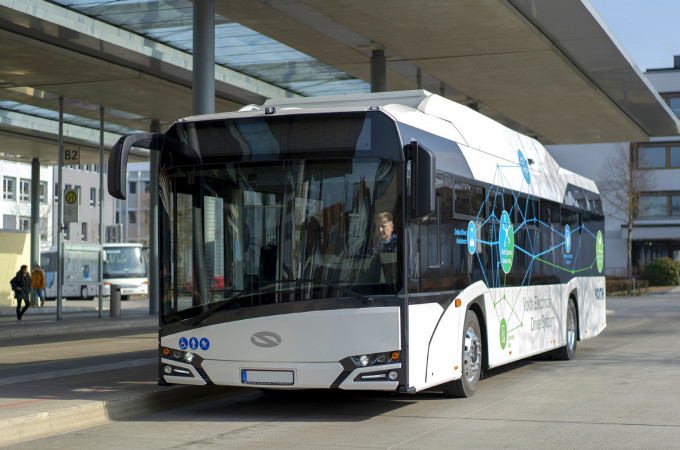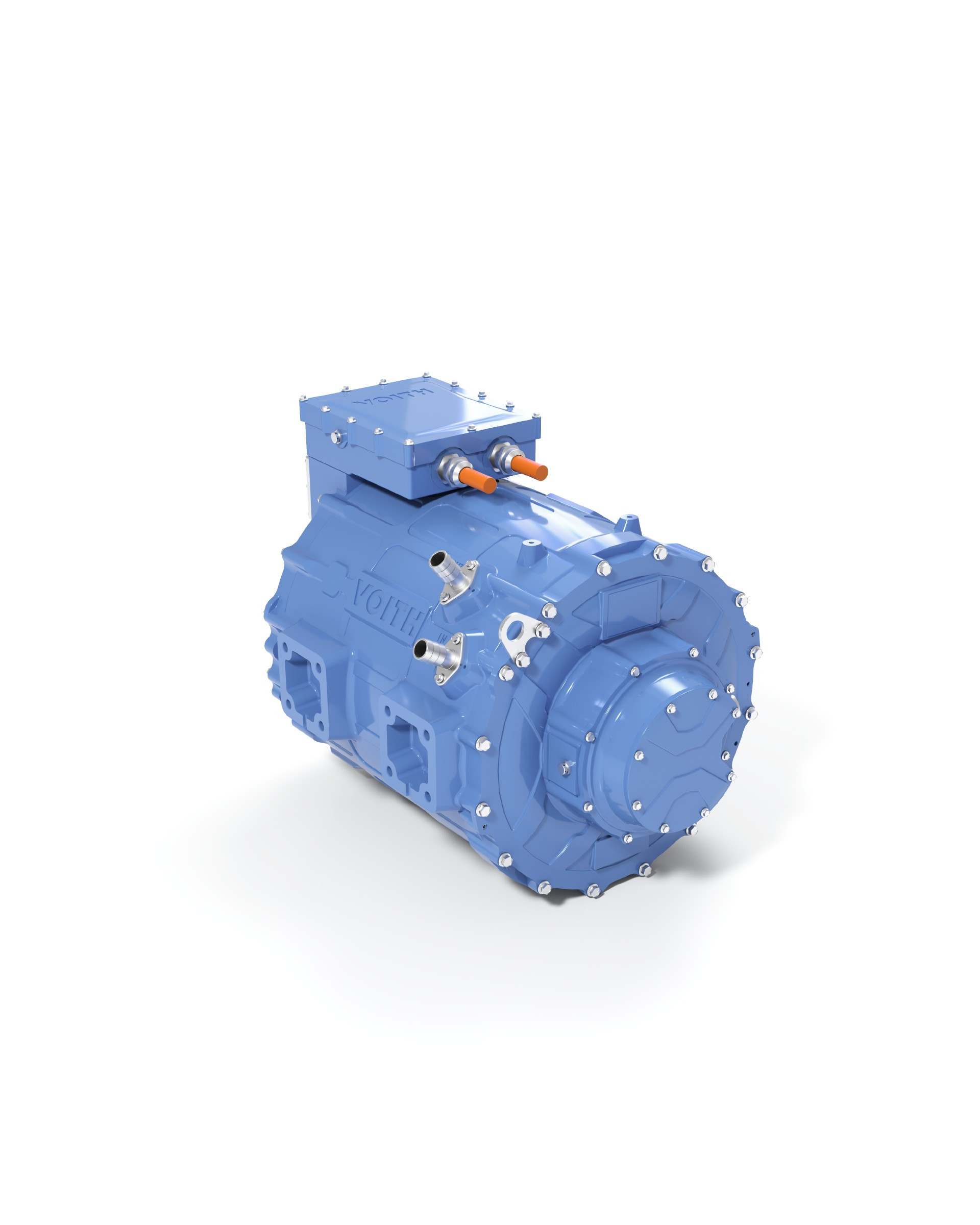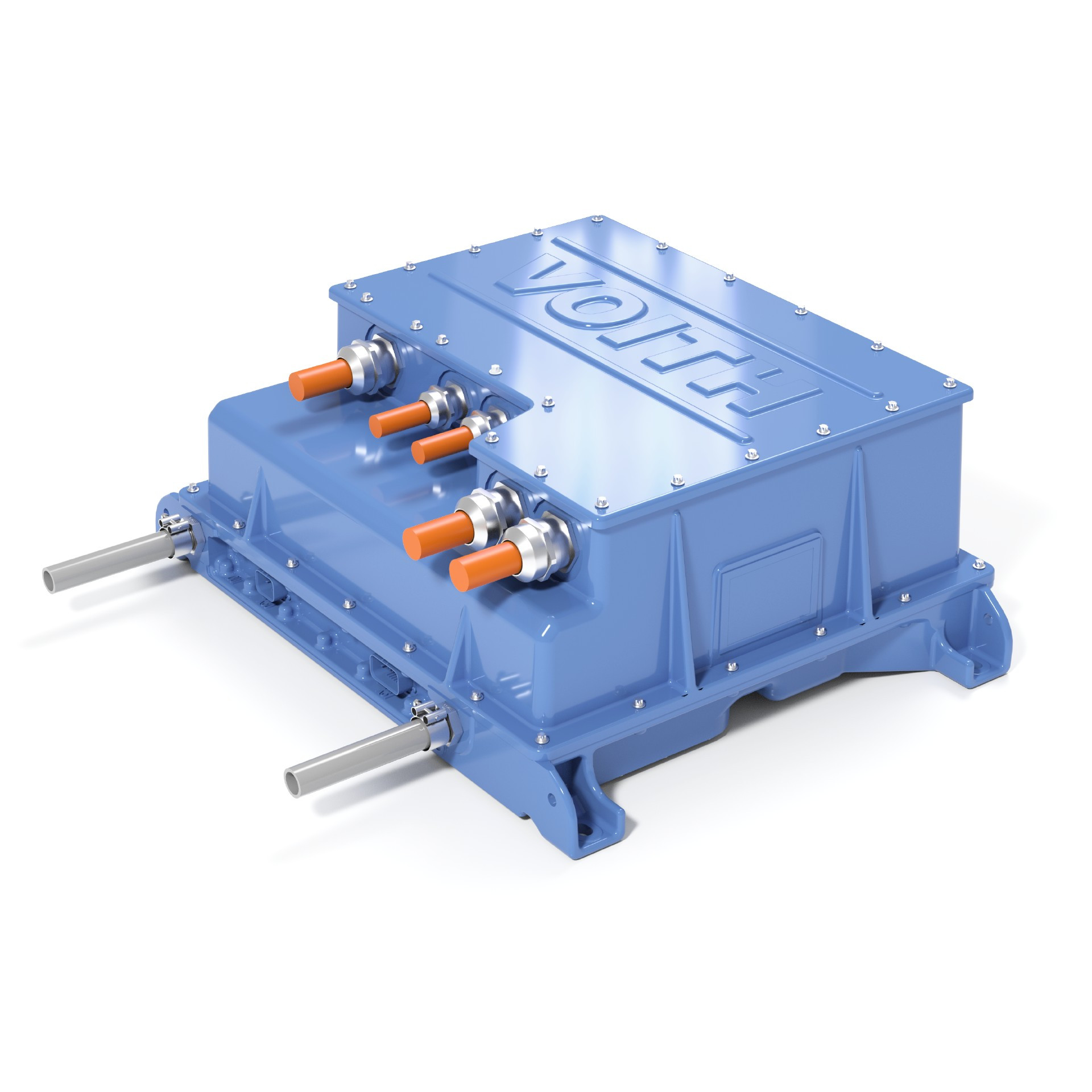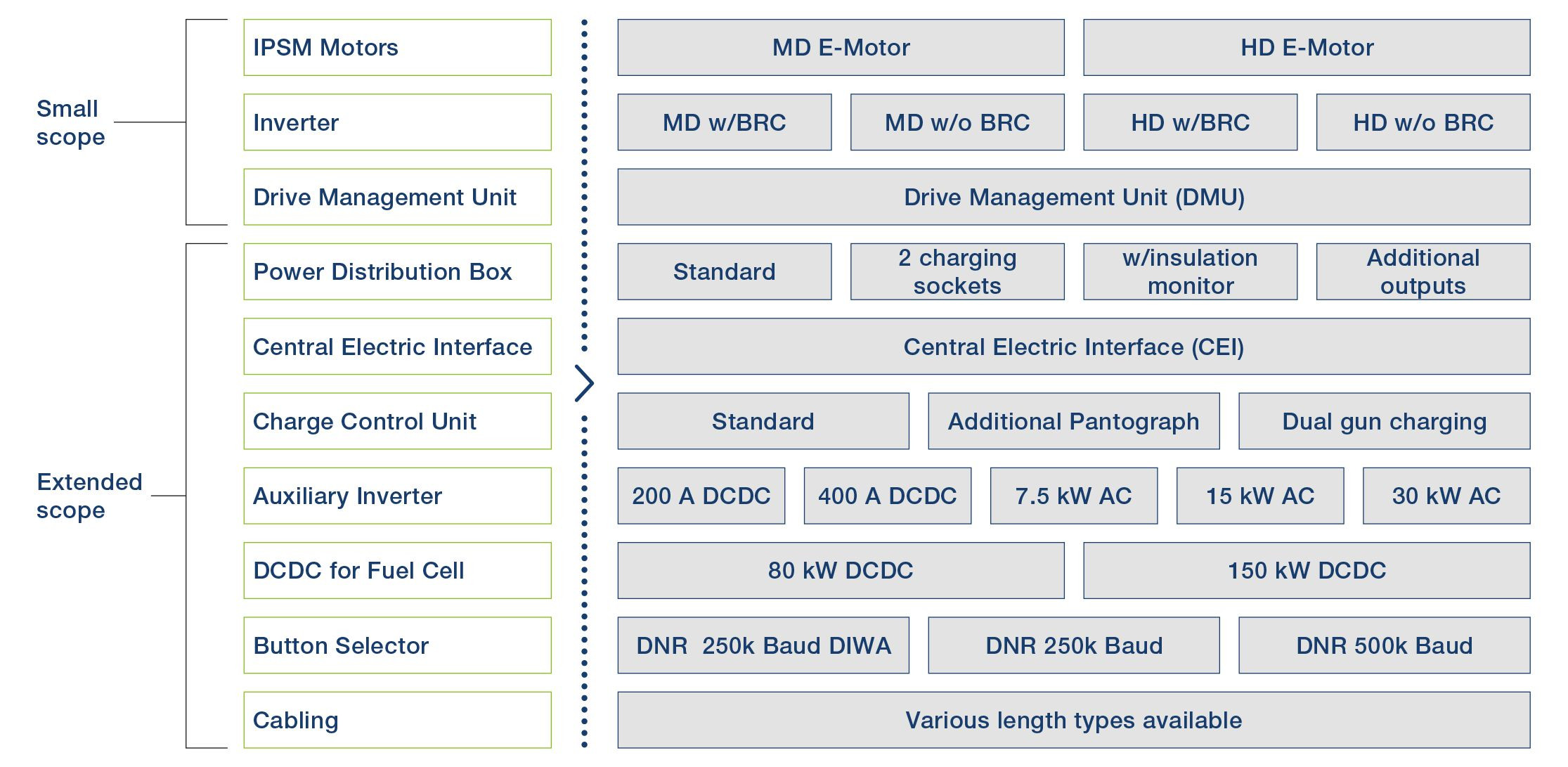Voith summarises key factors leading to the rise in global e-Mobility demand and announces new powertrain combination for HD trucks
By Jim Gibbins - 4th May 2022

Voith VEDS Demonstrator City Bus
Germany / World – ‘Vehicle markets worldwide are seeing governments introduce legislation to fast track the shift in powertrain type from vehicles with traditional combustion engine technology to vehicles powered using zero emission electric drive systems,’ writes Voith Turbo of Heidenheim in a recent press release.
‘The reason for this legislative change is clear; to reduce the world’s dependency on fossil fuels, reduce carbon dioxide emissions and slow / possibly reverse the rate of global warming.
‘While some countries are still planning a gradual change to low and zero emission vehicles over the next 30 to 40 years, others are driving change much faster by banning the total sale of gasoline or diesel vehicles completely within just a few years.’
Legislation and funding forcing paradigm shift says Voith
‘Regulations to manage this paradigm shift are, however, now in place in all major markets,’ writes Voith, ‘with significant impact and change to the new vehicle and existing marketplace expected to be in effect by or before the end of this decade.
‘While planned bans on the sale of new vehicles powered by fossil fuels in some countries will go some way towards reinforcing this shift, there are massive government investments in some countries to deliver this change. For example, the US government is planning to invest around USD 174 billion into the development of electric mobility in the next few years. A major part of this funding is intended for the electrification of school buses (USD 20 billion) and for the ongoing development of zero emission electric vehicles for public transport (USD 25 billion).
‘China, despite more than a decade of subsidized investment in electrification of two wheelers, cars and buses up until 2015, when it started to reduce the financial support, has set a target of climate neutrality by 2060; a target that is unlikely to be realized without further pressure on industry and incentives to adopt electric mobility. This view is despite, for example, there being more than 16,000 buses with electric drive systems already operating in the Shenzhen metropolitan area alone.
‘With its “Green Deal”* and “Clean Vehicles Directive”*, the EU has also committed itself to drastically reduce CO2 emissions and has set binding targets for the procurement of low emission and zero emission buses by 2030. Another aspect of this scenario is that when the Euro 7 and China 7 vehicle emission standards come into force (no date yet but expected somewhere between 2025 and 2030), operators will need to comply with an allocated allowance for CO2 emitted overall by their entire fleet or face fines. This additional compliance will also fuel the market for zero emission vehicles (ZEV).
‘All these measures show the worldwide endeavours that are under way to implement the provisions of the 2015 Paris Climate Accord. Nearly all governments in the world endorse this agreement, whose most important objective is to keep man-made global warming (global temperature rise) to less than 2 degrees Celsius above pre-industrial levels. The globally agreed key to implementing this goal is the drastic reduction of CO2 emissions. And here again, the focus is on transport, because from a global perspective, the transportation sector is responsible for around 25 percent of this greenhouse gas emission. Pushing ahead with electric mobility therefore means significantly reducing the amount of harmful emissions.’
Cost benefits for electric drive trains
‘From an economic perspective as well, legislative measures are also leading to a shift in balance: Given that the car industry is currently investing around €25 billion in research into modern battery technology, it can be assumed that the costs for batteries will fall rapidly and conversely, that their power density will increase enormously. With respect to total cost of ownership (TCO), therefore, electric drive trains will become increasingly less expensive, and it is forecast that soon be more cost effective than any combustion engine driven system. For buses and trucks, TCO parity is expected in less than five years.
‘Against this background, there is already increased demand from vehicle manufacturers for drive solutions for their next generations of vehicles. Whereas there are numerous vendors in the passenger car segment, the market in the commercial vehicle segment has been comparatively weak so far. This is due in part to the fact that the requirements for buses and powerful trucks (in the heavy duty (HD) segment) are far more complex than in the passenger car segment. Yet operators, manufacturers and many countries are pushing for this transition.
‘For example, one Irish bus operator (Translink) aims to have a complete zero-emission fleet by 2040. Some operators in the US are striving to operate their fleets exclusively with electric buses by 2030 (Metropolitan Transportation of Los Angeles, for example). Chile wants to have switched its public transport completely to electric buses by 2040. In the Netherlands, new tenders for bus fleets already prescribe electric drives only. And in Scandinavia, barely any other kind of tender still exists.’
VEDS – an integrated drive concept
‘Despite seemingly strong future demand, so far very few bus OEMs have been building their own electric drive trains. A far greater number are choosing to rely on innovative solutions from (tier 1) suppliers. For a system supplier like Voith, these circumstances represent a major opportunity. Building on its comprehensive expertise in efficient and reliable drive concepts for buses, trucks and off-road applications, the Heidenheim-based technology group has in recent years developed a complete drive train including software and driving dynamics. The Voith Electrical Drive System (VEDS) is now filling a crucial gap and gives OEMs the opportunity to benefit from the transition to electric mobility.’
‘When designing the system, Voith's development engineers consciously opted for completely new development of both electric motor and inverter. Alexander Denk, Vice President Product Management E-Mobility at Voith, explains why: “Standard industrial parts do not satisfy either Voith’s quality standards or the safety standards for passenger transport.” This is why Voith chose from the very start to tailor all key components, so they complement one another perfectly, from the electric motor, traction inverter and high-voltage distributor to the drive control and energy management software. The success of this approach is reflected in the consumption map. “We are distributing recuperated energy efficiently and can share it among components, because it does not always make sense to feed it back to the battery,” Denk adds, by way of example. In addition, the VEDS for buses does not need a separate transmission. This saves weight and increases range. Moreover, the compact design of the system makes it easier to install in barrier-free, low-floor buses.’
Two power classes configurable for buses
‘Depending on requirements, the VEDS for buses is available as a MD (medium-duty) or HD (heavy-duty) design. The MD motor represents a power class of 230 kW (continuous power; peak power of 260 kW) and is optimized for the requirements of inner-city traffic with low average speeds and frequent stopping and starting. The HD motor provides an output of 310 kW (continuous power; peak power of 410 kW) and is therefore suited to intercity/long distance traffic with higher average speeds. The VEDS has already proven its effectiveness repeatedly. There has been great feedback from customers who confirm that the Voith solution is significantly better than those of the competition: The VEDS guarantees better performance, lower consumption, a more comfortable ride and greater availability.

Voith VEDS - High voltage Motor
‘With respect to energy supply, it does not matter whether the commercial vehicle is fitted with a fuel cell or a battery. The concept supports battery systems from a wide range of manufacturers and is also suitable for use with hybrid fuel cell/electric vehicle drive trains. Thanks to this high level of modularization and adaptability in every respect, the VEDS offers many bus manufacturers the potential to establish themselves as key players for a cost-effective transition to sustainable mobility concepts.’

Voith VEDS - High voltage Inverter
A new powerful solution for commercial vehicles of up to 40 t
‘The general guidelines for the bus segment also apply to trucks. However, one challenge for electric drive trains in trucks is the levels of drive power required, which are very different from those in the bus segment. In addition, the focus in this sector is primarily on powerful heavy-duty (HD) transmissions (vehicles of more than 15 t) when it comes to the shift to electric mobility. Even conservative forecasts show that, worldwide, every third commercial vehicle will have an electric drive train by as early as 2030.
‘With a view to their use in inner-city traffic (e.g., refuse trucks), most developers (including Voith engineers) regard a gearless drive train as impractical. This is why,’ Voith explains, ‘its engineers designed their integrated drive train concept for commercial vehicles over 15 t to necessarily include an integrated electric transmission and high braking power. Voith has named this concept VEDS HD Plus. This range of trucks meets the requirements of OEMs in the truck segment and also offers a high degree of both modularity and standardization thanks to its various modules. The HD Plus range consists of electric motors, an inverter and an electric transmission and is also available for fuel cell vehicles.
‘As with the VEDS for buses, the truck manufacturer can choose between two high-speed electric motor variants. The technology group will introduce the first prototypes of the electric transmission it has developed in-house in the second quarter of 2022 and will showcase it to a wider public at the IAA transportation trade fair in Hanover.
‘With the VEDS, Voith has developed an essential building block to function as a driver of the mobility transition in the commercial vehicle segment. “The VEDS not only offers a complete, customized electric drive solution but at the same time gives OEMs a fast entry and transition to electric mobility and a faster return on investment than with rival systems,” says Denk.’

A diagram showing the current scope Voith's electric drive systems for buses and trucks
*Examples: The Clean Vehicles Directive & The Green Deal
The Clean Vehicles Directive by the EU promotes clean mobility solutions in public procurement tenders, providing a solid boost to the demand and further deployment of low- and zero-emission vehicles. The Directive defines clean vehicles and sets national targets for their public procurement. Adopted by the European Parliament & Council in June 2019, the Directive was needed to be transposed into national law by August 2, 2021.
The Green Deal - In 2019, the European Commission adopted a set of proposals to make the EU's climate, energy, transport and taxation policies fit for reducing net greenhouse gas emissions by at least 55% by 2030, compared to 1990 levels.



-of-Knorr-Bremse-AG.jpg?w=400&h=225&fit=crop)